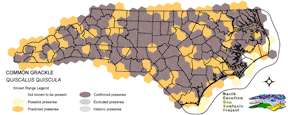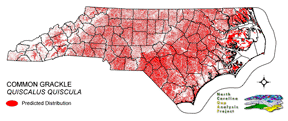
| Taxa: |
| Order: |
| Family: |
| Aves |
| Passeriformes |
| Icteridae |
| NatureServe Global Rank: |
| NatureServe State (NC) Rank: |
| G5 |
| S5B,S5N |
| Federal Status: |
| NC State Status: |
| --- |
| --- |


| Land Unit |
| US Fish & Wildlife Service |
| US Forest Service |
| US National Park Service |
| US Department of Defense |
| NC State Parks |
| NC University System |
| NC Wildlife Res. Com. |
| NC Forest Service |
| NC Div. of Coastal Mgmt. |
| Local Governments |
| Non-Governmental Org. |
| Other Public Lands |
| Private Lands |
| GAP Status 1-2 |
| All Protected Lands |
| Statewide |
| Hectares |
| 24,849.45 |
| 23,871.60 |
| 75,091.32 |
| 14,392.08 |
| 8,189.19 |
| 4,438.89 |
| 32,816.88 |
| 4,844.46 |
| 2,304.99 |
| 1,315.53 |
| 5,351.76 |
| 3,507.57 |
| 5,168,954.25 |
| 61,403.79 |
| 198,289.38 |
| 5,369,927.97 |
| Acres |
| 61,404.32 |
| 58,988.00 |
| 185,554.66 |
| 35,563.60 |
| 20,235.93 |
| 10,968.73 |
| 81,092.26 |
| 12,247.73 |
| 5,695.75 |
| 3,250.74 |
| 13,224.48 |
| 8,667.39 |
| 12,772,761.63 |
| 152,008.85 |
| 490,260.44 |
| 13,269,655.22 |
| % of Dist. on |
| Prot. Lands |
| 12.5 % |
| 12.0 % |
| 37.5 % |
| 7.3 % |
| 4.1 % |
| 2.2 % |
| 16.0 % |
| 2.4 % |
| 1.2 % |
| 2.6 % |
| 2.6 % |
| 1.4 % |
| < 0.1 % |
| 31.0 % |
| ----- |
| ----- |
| % of Dist. on |
| All Lands |
| 0.5 % |
| 0.4 % |
| 1.4 % |
| 0.3 % |
| 0.2 % |
| < 0.1 % |
| 0.6 % |
| < 0.1 % |
| < 0.1 % |
| < 0.1 % |
| < 0.1 % |
| < 0.1 % |
| 96.3 % |
| 1.1 % |
| ----- |
| ----- |
|
Common throughout the state, except absent in the high elevations of the mountains (Potter et al. 1980). Occurs in places where foraging areas (consisting of short grass, farmland, or wetlands) occur adjacent to nesting areas (such as dense conifer stands, riparian forests, shrub swamps, roadside trees and shrubs, and forest edges) (Nicholson 1997). Common near human habitation (Ehrlich et al. 1988). Generally nests up to 100 feet above the ground in trees (Ehrlich et al. 1988), but will also nest in clumps of cattails over water, old woodpecker holes and other tree cavities, rafters under the eaves of outbuildings, and in the sides of active Osprey nests (Skutch 1996) NATURE SERVE GLOBAL HABITAT COMMENTS: Partly open situations with scattered trees, open woodland, forest edge, marsh edges, islands, swamp thickets, coniferous groves, cities, suburbs, farms; in migration and winter also in open situations, cultivated lands, fields. Nests in deciduous or coniferous trees up to 18 m above ground, also shrubs, roadside plantings, swamp vegetation, natural cavities, marshes. |
| Code | Name | Description | NC Natural Heritage Program Equivalent |
| 3 | Tidal Marsh | Fresh and brackish tidal marshes, including cord grass, wild rice, sawgrass and needlerush alliances. | Brackish Marsh, Interdune pond, Maritime wet grassland |
| 124 | Maritime Scrubs and Tidal Shrublands | Coastal shrubs including wax-myrtle, swamp rose, alder, yaupon, and greenbriar. | Maritime Shrubs, Salt Shrub |
| 375 | Hypersaline coastal salt flats | Tidal flats within salt marshes, including saltmeadow cordgrass or sea-purslane dominated alliances. | Salt Marsh |
| 372 | Interdune Herbaceous Wetlands | Dune swales with permanently flooded to intermittently exposed hydrology. Species composition depends on salinity and can include cut grass, spike-rush, mosquito fern, and hornwort. | Interdune Pond, Maritime Wet Grasslands |
| 371 | Maritime Grasslands | Dune grass community consisting of sea oats and beach grasses. | Dune grass, Maritime dry grassland |
| 17 | Maritime Forests and Hammocks | Maritime forests and woodlands dominated by live or sand laurel oak. Estuarine Fringe forests dominated by loblolly pine. | Coastal Fringe Evergreen Forest, Maritime Deciduous Forest, Maritime Deciduous Forest |
| 97 | Mesic Longleaf Pine | Longleaf pine woodlands without a major scrub oak component. Slash or loblolly pines may be present as well. | Mesic Pine Flatwoods |
| 42 | Xeric Longleaf Pine | Sandhills including a range of longleaf pine density from predominantly wiregrass, scrub oak dominated to true longleaf pine woodland. This does not include mesic or saturated flatwood types. | Xeric Sandhill Scrub, Pine/Scrub Oak Sandhill, Coastal Fringe Sandhill |
| 46 | Xeric Oak - Pine Forests | Mixed forest dominated by yellow pines with white or northern red oaks co-dominating. | Pine Oak Heath |
| 232 | Xeric Pine-Hardwood Woodlands and Forests | Mixed forest dominated by yellow pines with drier oaks including southern red, post, and chestnut oaks. | Dry Oak Hickory Forest |
| 226 | Piedmont Xeric Woodlands | Generally post and blackjack oak dominated woodlands. White ash and pignut hickory can be found in combination with Eastern red cedar on glades. | Xeric Hardpan Forest |
| 20 | Coniferous Regeneration | Regenerating pine stands. Predominantly loblolly pine, but slash and longleaf stands occur as well. | No equivalent |
| 36 | Successional Deciduous Forests | Regenerating deciduous trees with a shrub stature. Commonly dominated by sweetgum, tulip poplars and maples. | No equivalent |
| 180 | Agricultural Crop Fields | Farm fields used for row crops. | No equivalent |
| 205 | Agricultural Pasture/Hay and Natural Herbaceous | Farm fields used for pasture grass or hay production, as well as old fields dominated by native and exotic grasses. | No equivalent |
| 202 | Residential Urban | Includes vegetation interspersed in residential areas. Includes lawns, mixed species woodlots, and horticultural shrubs. Vegetation accounts for between 20 - 70% of the cover. | No equivalent |
| 203 | Urban Low-Intensity Developed | Highly developed areas with vegetation accounting for < 20% of the cover. | No equivalent |
|
Caccamise, D. F., L. A. Lyon, and J. Fischl. 1983. Seasonal patterns in roosting flocks of starlings and commongrackles. Condor 85:474-481.
Bjorklund, M. 1991. Evolution, phylogeny, sexual dimorphism and mating system in the grackles (QUISCALUS spp.:Icterinae). Evolution 45:608-621. Nelms, C. O., et al. 1994. Population estimates of breeding blackbirds in North Dakota, 1967, 1981-1982, and 1990. Am. Midl. Nat. 132:256-263. Nicholson CP. 1997. Atlas of the breeding birds of Tennessee. Knoxville: University of Tennessee Press. Cummings, J. L., J. L. Guarino, and C. E. Knittle. 1989. Chronology of blackbird damage to sunflowers. Wildl. Soc. Bull. 17:50-52. Bent, A.C. 1958. Life histories of North American blackbirds, orioles, tanagers, and their allies. U.S. National Museum Bulletin 211. Washington, DC. Harrison, C. 1978. A field guide to the nests, eggs and nestlings of North American birds. Collins, Cleveland, Ohio. Harrison, H.H. 1979. A field guide to western birds' nests. Houghton Mifflin Company, Boston. 279 pp. Potter, E. F., J. F. Parnell, and R. P. Teulings. 1980. Birds of the Carolinas. Univ. North Carolina Press, Chapel Hill. 408 pp. Terres, J.K. 1980. The Audubon Society encyclopedia of North American birds. Alfred A. Knopf, New York. American Ornithologists' Union (AOU), Committee on Classification and Nomenclature. 1983. Check-list of North American Birds. Sixth Edition. American Ornithologists' Union, Allen Press, Inc., Lawrence, Kansas. Ehrlich, P.R., D.S. Dobkin, and D. Wheye. 1988. The birder's handbook:a field guide to the natural history of North American birds. Simon and Shuster, Inc., New York. xxx + 785 pp. Glahn, J.F., et al. 1991. Impact of roost control on local urban and agricultural blackbird problems. Wildlife Society Bulletin 19:511-522. Droege, S., and J.R. Sauer. 1990. North American Breeding Bird Survey, annual summary, 1989. U.S. Fish and Wildlife Service, Biological Report 90(8). 22 pp. Zink, R.M., W.L. Rootes, and D.L. Dittman. 1991. Mitochondrial DNA variation, population structure, and evolution of the common grackle (QUISCALUS QUISCALA). Condor 93:318-329. |
For more information please contact them at:
NC-GAP Analysis Project
Dept. of Zoology, NCSU
Campus Box 7617
Raleigh, NC 27695-7617
(919) 513-2853
www.basic.ncsu.edu/ncgap